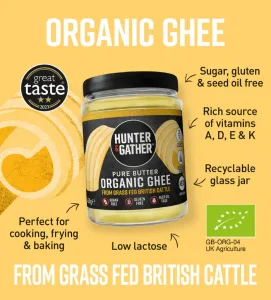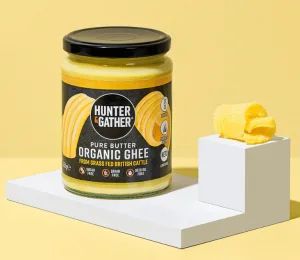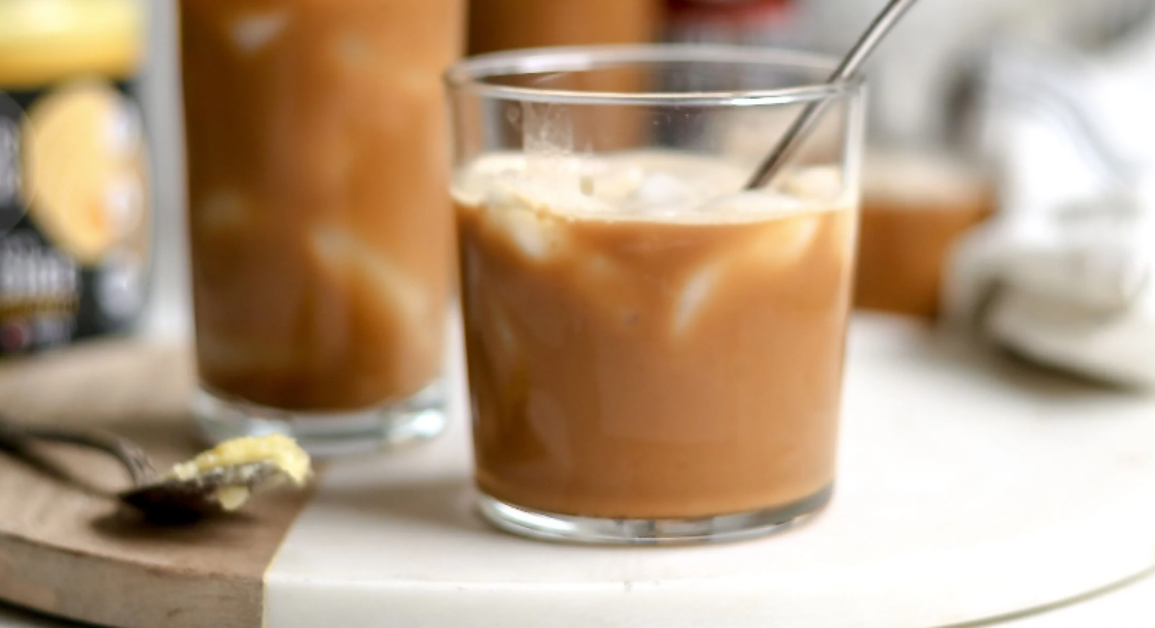Getting to Grips with Ghee (and perhaps a Dairy Intolerance)
I’d never really thought about using ghee, apart from when seeing it listed as an ingredient in Asian recipes. But last summer, when judging the Great Taste Awards, a fellow judge was extolling the health benefits of ghee. I have to say, I was very surprised, so decided to check it out for myself.
The first ghee I tried was from Hunter & Gather – a great company that creates real food and supplements that are not only free from refined sugar, grains, and inflammatory seed oils, but also champion quality and taste. It was delicious and added another depth of flavour to many of my recipes.
I’ve since tried other brands but would recommend starting (and sticking) with Hunter & Gather, especially if you’re uninitiated.

So, What is Ghee?
Ghee is a class of clarified butter which is made from cow or buffalo milk. It is made by melting butter until it has separated into liquid fats and milk solids. Once separated, the milk solids are removed and the liquid re-sets to create ghee.
Often used instead of oil in Middle Eastern cuisines, ghee has also been used in traditional medicine and even in religious rituals where it is referred to as “the sacred fat.”
As the clarification process removes milk solids and water, ghee is a more concentrated source of fats compared with butter. Being high in fat with low carbs, ghee is a great food to include as part of your Keto or Low Carb lifestyle.
How to Cook with Ghee
Ghee is an extremely versatile fat which has many uses in cooking. On the link here there is a great recipe for Cauliflower Cheese using ghee.
Removing the milk solids from butter gives ghee a much higher smoke point, so that it can be used in high heat cooking. It can be used to replace butter or vegetable oils in almost any recipe and is suitable for temperatures from sautéing to deep frying.
When making ghee, once melted it is allowed to simmer and almost caramelise before it is strained, giving an extremely rich taste and nutty aroma. This can explain why ghee is the chosen fat in recipes with huge flavour, such as curries.
Ghee remains soft and buttery at room temperature but will harden and granulate if stored in the fridge. You can use ghee to replace butter or vegetable oil in like for like quantities, simply spoon out of the tub and get cooking.
You can also melt ghee and add it to meals and drinks for a boost of healthy fats – ideal for Keto lifestyles.
There’s a great recipe for Chicken Tikka on the link here

What is a Dairy Allergy?
A dairy allergy is an allergy to dairy products such as butter and milk, which causes a physical reaction of varying severities when dairy is consumed.
Food allergies are usually far more serious than food intolerances. They are caused by the immune system mistaking certain proteins in foods as a threat. In response, it releases chemicals which cause an allergic reaction. This can be anything from a rash and itchiness to swelling, choking, and even breathing difficulties.
If a person has a dairy allergy they must avoid dairy products and ingredients altogether, as the reaction could be severe or even life threatening otherwise.
What is Dairy Intolerance?
Dairy intolerance on the other hand is usually far less severe and can be described as more of a sensitivity.
The intolerance can be caused by several factors including genetics, medical conditions, an inability to produce certain enzymes (as with lactose intolerance) and even stress & psychological factors.
If someone with a dairy intolerance eats dairy, it is the digestive system which reacts – rather than the immune system. Therefore, it makes sense that reactions are usually digestive and can include bloating, cramping, diarrhoea, nausea, and vomiting.
Not to say that these reactions aren’t incredibly unpleasant or damaging to health, but intolerances are not immediately life threatening – whereas allergies can be.
Dairy Allergy vs Dairy Intolerance
Without getting too complicated, dairy allergies and dairy intolerances are usually very different. This is due to both what causes them as well as the effects they have on the body. In summary:
Dairy Allergy – the immune system reacts to proteins found in dairy and dairy products, causing a more severe reaction.
Dairy Intolerance – the digestive system lacks enzymes needed to digest sugars found in dairy and dairy products, causing a less severe reaction.
Dairy intolerance – the most common being lactose intolerance (an inability to produce the enzyme lactase) – is far more common than dairy allergy. In fact, it affects around 65% of adults compared with just 2% of adults who suffer with a dairy allergy.
Signs You May Have a Dairy Intolerance or Allergy
The most common signs and symptoms that you may have a dairy intolerance or allergy are a reaction after eating dairy. As mentioned, this could be anything from a bad stomach to cramps, pains, rashes, swelling and even trouble breathing.
No matter your symptoms, if you think you may have any kind of food allergy or intolerance you should discuss it with your GP as soon as possible – and avoid the food in question in the meantime.
Your GP will be able to arrange tests to identify which food or foods you are intolerant or allergic to. This is usually a blood test which is conducted in a safe and monitored environment.
Foods to Avoid with a Dairy Intolerance or Allergy
The best way to live with a food intolerance or allergy is to avoid the food you are intolerant or allergic to altogether.
This would be a lot easier if it was a whole food you could easily look out for – but in reality dairy ingredients are often hidden in unsuspecting food products and so it’s a little trickier than that!
Here are some of the foods and ingredients to look out for and avoid if you have a dairy allergy or intolerance.
Milk
Butter
Yoghurt
Cheese
Lactose
Whey
Casein
Cream
Ice Cream
Can You Eat Ghee with a Dairy Intolerance?
Ghee is made using butter, which is a dairy product – so it would be reasonable to think that ghee should not be eaten by someone with a dairy intolerance.
After all, butter contains milk solids – which contain lactose, whey, and casein, all of which are not suitable for those with a dairy intolerance.
However, when making ghee the butter is slowly heated over 6-8 hours, this removes excessive moisture and causes the milk solids within butter to sink to the bottom.
As part of the ghee making process, these milk solids are later removed – leaving behind a clarified butter which does contains little to no lactose, whey, or casein those with an intolerance would react from.
Because most dairy allergens are removed during the process of making ghee, we advise that some people who are intolerant to dairy may find that they can utilise ghee.
Can You Eat Ghee with a Dairy Allergy?
If you have a dairy allergy on the other hand, we will definitely not advise even trying ghee. It is simply not worth the potentially life-threatening consequences.
If you have a dairy allergy, steer clear of ghee altogether!
Hunter & Gather Organic Grass Fed Ghee
Is an organic certified clarified butter, made from local UK Grass Fed Dairy. Low Lactose & Casein and packed with Vitamin A, D, E, K & Omega 3
Hunter & Gather Ghee is made using cream from British Grass Fed Cattle, which is certified Organic and is top quality.
They don’t add anything else to their ghee – none of the fats or vegetable and seed oils often used to bulk out the recipe of poorer quality ghee. Just 100% natural ghee.
The result is a silky smooth and buttery rich ghee, perfect for adding to meals, recipes, and your morning Bulletproof Coffee for a boost of health optimising fats.
How Much is it?
It’s not cheap, at £16 for a 450g jar, but you can subscribe and then its reduced to £14.40. But at the end of the day, ‘you are what you eat’ and ‘you’re worth it’ to use a couple of cliches.
With thanks to Hunter & Gather for this information:
“All information provided on our website and within our articles is simply information, opinion, anecdotal thoughts, and experiences to provide you with the tools to thrive.
It is not intended to treat or diagnose symptoms and is definitely not intended to be misconstrued for medical advice. We always advise you seek the advice of a trained professional when implementing any changes to your lifestyle and dietary habits.
We do however recommend seeking the services of a trained professional who questions the conventional wisdom to enable you to become the best version of yourself.”
The Seasoned Gastronome


